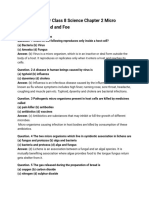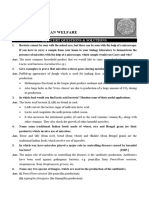0 ratings0% found this document useful (0 votes)
2 viewsMicroorganisms Worksheet
Microorganisms Worksheet
Uploaded by
shreyanshgupta2408This document is a worksheet containing questions related to microorganisms, their classification, and their roles in various processes. It includes fill-in-the-blank questions, multiple-choice questions, and matching exercises about diseases, antibiotics, and the contributions of notable scientists. Additionally, it prompts students to explore the living environments of microorganisms and their impact on health and food preservation.
Copyright:
© All Rights Reserved
Available Formats
Download as PDF, TXT or read online from Scribd
Microorganisms Worksheet
Microorganisms Worksheet
Uploaded by
shreyanshgupta24080 ratings0% found this document useful (0 votes)
2 views2 pagesThis document is a worksheet containing questions related to microorganisms, their classification, and their roles in various processes. It includes fill-in-the-blank questions, multiple-choice questions, and matching exercises about diseases, antibiotics, and the contributions of notable scientists. Additionally, it prompts students to explore the living environments of microorganisms and their impact on health and food preservation.
Copyright
© © All Rights Reserved
Available Formats
PDF, TXT or read online from Scribd
Share this document
Did you find this document useful?
Is this content inappropriate?
This document is a worksheet containing questions related to microorganisms, their classification, and their roles in various processes. It includes fill-in-the-blank questions, multiple-choice questions, and matching exercises about diseases, antibiotics, and the contributions of notable scientists. Additionally, it prompts students to explore the living environments of microorganisms and their impact on health and food preservation.
Copyright:
© All Rights Reserved
Available Formats
Download as PDF, TXT or read online from Scribd
Download as pdf or txt
0 ratings0% found this document useful (0 votes)
2 views2 pagesMicroorganisms Worksheet
Microorganisms Worksheet
Uploaded by
shreyanshgupta2408This document is a worksheet containing questions related to microorganisms, their classification, and their roles in various processes. It includes fill-in-the-blank questions, multiple-choice questions, and matching exercises about diseases, antibiotics, and the contributions of notable scientists. Additionally, it prompts students to explore the living environments of microorganisms and their impact on health and food preservation.
Copyright:
© All Rights Reserved
Available Formats
Download as PDF, TXT or read online from Scribd
Download as pdf or txt
You are on page 1of 2
Chapter- 2
Worksheet-1
1. Citrus canker is a _____________disease caused by __________.
2. A ____________________is used to study microbes.
3. _______________________ is a unicellular fungus.
4. Tiny organisms which cannot be seen with the naked eyes are
called
(a) microorganisms
(b) animals
(c) fungi
(d) bacteria
5. Bacteria are organisms.
(a) multicellular
(b) unicellular
(c) bicellular
(d) tricellular
6. Simple, plant-like microorganisms are called
(a) algae
(b) bacteria
(c) both (a) and (b)
(d) protozoa
7. The process in which sugar in the food is transformed into alcohol
and carbon dioxide by using microorganisms is known as
(a) transformation
(b) beverage
(c) fermentation
(d) respiration
8. The fungus that is commonly used in bakery and beverage
industries is
(a)Penicillium
(b) Yeast
(c) Agaricus
(d) Rhizopus
9. Match the names of scientists given in Column A with the
discovery made by them given in Column B.
Column A Column B
(a) Louis Pasteur (i) Penicillin
(b) Robert Koch (ii) anthrax bacterium
(c) Edward Jenner (iii) Fermentation
(d) Alexander Fleming (iv) small pox vaccine
(v) Typhoid
10. Classify the following into friendly and harmful microorganisms.
Yeast, malarial parasite, Lactobacillus, bread mould, Rhizobium,
Bacillus anthracis.
11. Where do Microorganisms Live?
11.Mention
12. Where dotheMicroorganisms Live?
role of Lactobacillus.
13. Name two commonly used antibiotics.
12.Who
14. Mention the rolethe
discovered of Lactobacillus.
vaccine and when?
15. Comment on Biological nitrogen fixers.
16.
13.What
Name are communicable
two commonly useddiseases?
antibiotics.
17. Name a bacterial and a viral disease in animal.
14. Who discovered the vaccine and when?
18. How is food poisoning caused?
19. What are preservatives?
20. Explain in brief nitrogen cycle.
You might also like
- CLASS VIII QUESTION BANK - 2. MicroorganismsDocument6 pagesCLASS VIII QUESTION BANK - 2. MicroorganismsSurbhi Nayar100% (1)
- NCERT Exemplar Solution Class 8 Science Chapter 2 4Document11 pagesNCERT Exemplar Solution Class 8 Science Chapter 2 4Adiba ShahNo ratings yet
- STD 8 CH 2 Microorganisms Friend and FoeDocument11 pagesSTD 8 CH 2 Microorganisms Friend and FoeHIRAL SOLANKINo ratings yet
- bio DPP Micro organism 10 july 24 pms SCHOOLDocument2 pagesbio DPP Micro organism 10 july 24 pms SCHOOLlearningroom78No ratings yet
- CHAPTER - 2 MICROORGANISMS FRIEND AND FOE EK-PYQ QUESTIONS FINALDocument4 pagesCHAPTER - 2 MICROORGANISMS FRIEND AND FOE EK-PYQ QUESTIONS FINALnorahnebuNo ratings yet
- Chapter 2: Microorganisms: Friend and FoeDocument5 pagesChapter 2: Microorganisms: Friend and FoeShwetaNo ratings yet
- Class 8 Micro Organisms Friend and Foe WorksheetDocument2 pagesClass 8 Micro Organisms Friend and Foe WorksheetAruna HariharanNo ratings yet
- Class 8 Science CH 2Document32 pagesClass 8 Science CH 2Diya JainNo ratings yet
- Name: - Date TakenDocument3 pagesName: - Date TakenNicole DomingoNo ratings yet
- 11460018__638243318826965166_MICROORGANISMWORKBOOKDocument12 pages11460018__638243318826965166_MICROORGANISMWORKBOOKLatif Ahmad DarNo ratings yet
- Question Bank With Answers - 1594999819195Document7 pagesQuestion Bank With Answers - 1594999819195Bennett JohnNo ratings yet
- CH2_ANSWER_KEY_OF_ASSIGNMENTDocument3 pagesCH2_ANSWER_KEY_OF_ASSIGNMENTrevyblack720No ratings yet
- NCERT Exemplar Solutions For Class 8 Science Chapter 2 Microorganisms Friend and FoeDocument10 pagesNCERT Exemplar Solutions For Class 8 Science Chapter 2 Microorganisms Friend and FoePradipti VermaNo ratings yet
- Heep 102Document6 pagesHeep 102pk2varmaNo ratings yet
- Science Class Viii Practice Test 02 Chapter 02 Microorganisms Friend and Foe AnswersDocument5 pagesScience Class Viii Practice Test 02 Chapter 02 Microorganisms Friend and Foe Answerskuldeepsingh rathoreNo ratings yet
- Microbiology 100 Quiz 1 A Drop FileDocument2 pagesMicrobiology 100 Quiz 1 A Drop FileDeborah StahlNo ratings yet
- F. Y. B. Sc. (Microbiology) Paper-I Question Bank PDFDocument16 pagesF. Y. B. Sc. (Microbiology) Paper-I Question Bank PDFSourav SenNo ratings yet
- F. Y. B. Sc. (Microbiology) Paper-I Question Bank PDFDocument16 pagesF. Y. B. Sc. (Microbiology) Paper-I Question Bank PDFShipra ChakrabortyNo ratings yet
- CH-2 Microorganisms (FINAL)Document12 pagesCH-2 Microorganisms (FINAL)Abhishek PatidarNo ratings yet
- Class-8 Chapter-2 SCIENCEDocument4 pagesClass-8 Chapter-2 SCIENCEVivek PatidarNo ratings yet
- Microorganisms - Friend and Foe - 4MDocument4 pagesMicroorganisms - Friend and Foe - 4MFree direNo ratings yet
- Chapter 8Document19 pagesChapter 8t6726730No ratings yet
- Microorganism Back ExersiceDocument2 pagesMicroorganism Back ExersicedigitalNo ratings yet
- Microorganism Back Exersice (1)Document2 pagesMicroorganism Back Exersice (1)digitalNo ratings yet
- Adobe Scan 06 Jul 2023Document4 pagesAdobe Scan 06 Jul 2023jiteshgarg14No ratings yet
- Micro Organisms Friend and FoeDocument10 pagesMicro Organisms Friend and Foearfeenanas777No ratings yet
- microorganismDocument2 pagesmicroorganismdalingua21No ratings yet
- CH 2Document4 pagesCH 2Viraaj SinghNo ratings yet
- Study Pack 1 Practice TestDocument13 pagesStudy Pack 1 Practice TestKoloti JaereamanNo ratings yet
- NCERT Science ExemplarDocument10 pagesNCERT Science Exemplargunjantiwari079No ratings yet
- ch2 Science Part Second 8thDocument3 pagesch2 Science Part Second 8thtejasj2002No ratings yet
- Class 12 Biology - Microbes in Human Welfare Important Questions (1)Document7 pagesClass 12 Biology - Microbes in Human Welfare Important Questions (1)ambekamarak331No ratings yet
- Selina Concise Biology Class 9 ICSE Solutions For Chapter 9 - Economic Importance of Bacteria and FungiDocument12 pagesSelina Concise Biology Class 9 ICSE Solutions For Chapter 9 - Economic Importance of Bacteria and Fungiprathamk884100% (1)
- Biological ClassificationDocument5 pagesBiological Classificationpaneerbiryani2804No ratings yet
- Text Book Question & Answer: Question 1. Fill in The Blanks: (A) Microorganisms Can Be Seen With The Help of ADocument4 pagesText Book Question & Answer: Question 1. Fill in The Blanks: (A) Microorganisms Can Be Seen With The Help of ANisha ThapaNo ratings yet
- G 8 Microorganisms WorksheetDocument5 pagesG 8 Microorganisms Worksheetmittal3458No ratings yet
- Ls Sci CH 2Document28 pagesLs Sci CH 2ekamgamerpagalNo ratings yet
- bio DPP Micro organism 8 aug 24 SSC SCHOOL - CopyDocument2 pagesbio DPP Micro organism 8 aug 24 SSC SCHOOL - Copylearningroom78No ratings yet
- CBSE Class 8 Science WorksheetDocument3 pagesCBSE Class 8 Science Worksheetravilulla60% (5)
- Chapter 2 Dpps (Microorganism)Document7 pagesChapter 2 Dpps (Microorganism)pratik.shindeNo ratings yet
- Class 8 Science CH 2worksheet 2020Document4 pagesClass 8 Science CH 2worksheet 2020Jagriti KhatriNo ratings yet
- chapter 2 8th scienceDocument7 pageschapter 2 8th sciencesunilchoudhary192007No ratings yet
- Chapter 1 Questions and AnswersDocument88 pagesChapter 1 Questions and AnswersApryll DarlineNo ratings yet
- Microbes in Human WelfareDocument19 pagesMicrobes in Human Welfareagrimg80No ratings yet
- Class-8 Science Extra QuestionsDocument11 pagesClass-8 Science Extra Questionsnirmal krisnaNo ratings yet
- 7th CompetitonDocument4 pages7th CompetitonekkyNo ratings yet
- Chapter - 2 Micro-Organisms: Friend and FoeDocument11 pagesChapter - 2 Micro-Organisms: Friend and FoeUmar QuaziNo ratings yet
- Untitled Document 5Document6 pagesUntitled Document 5Khan SahilNo ratings yet
- Advantage and Disadvantage of Microorganisms and Multiple ChoicesDocument2 pagesAdvantage and Disadvantage of Microorganisms and Multiple ChoicesEspie Rose DumalagNo ratings yet
- Worksheet Class-Viii SUBJECT - Science CHAPTER-2, Microorganisms: Friends or Foes A. Fill in The BlanksDocument3 pagesWorksheet Class-Viii SUBJECT - Science CHAPTER-2, Microorganisms: Friends or Foes A. Fill in The BlanksKANISHKA SHARMANo ratings yet
- BIO 275 - Chapter 1 QuestionsDocument1 pageBIO 275 - Chapter 1 QuestionsLindsey StilleyNo ratings yet
- Class 8 Chapter 2 Questions and AnswersDocument4 pagesClass 8 Chapter 2 Questions and AnswersharshvivekrajNo ratings yet
- C 8 BIO WS 6 (1)Document4 pagesC 8 BIO WS 6 (1)amirthaaraghavan9No ratings yet
- ch10Document20 pagesch10satyakantajNo ratings yet
- SummaryofreportmicrobioDocument5 pagesSummaryofreportmicrobiomysterioushumaneNo ratings yet
- Solution Manual For Nester's Microbiology: A Human Perspective, 10th Edition, Denise Anderson, Sarah Salm Eugene NesterDocument45 pagesSolution Manual For Nester's Microbiology: A Human Perspective, 10th Edition, Denise Anderson, Sarah Salm Eugene Nestersimomeliimii100% (3)
- BIOS1Document38 pagesBIOS1Natukunda DianahNo ratings yet
- Class 12 - Biology - Microbes in Human WelfareDocument6 pagesClass 12 - Biology - Microbes in Human WelfarePihu JaniNo ratings yet
- Microrgasnism 8thDocument3 pagesMicrorgasnism 8thtufailraina7No ratings yet
- Are All Bacteria Dangerous? Biology Book for Kids | Children's Biology BooksFrom EverandAre All Bacteria Dangerous? Biology Book for Kids | Children's Biology BooksNo ratings yet



























































